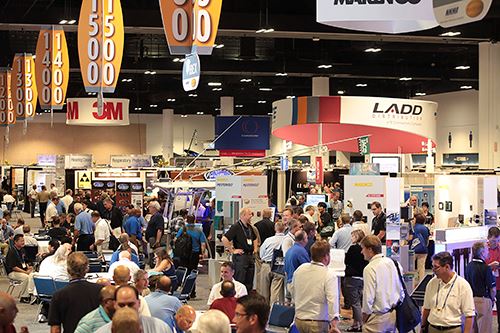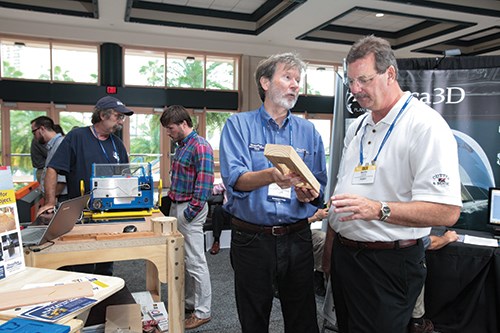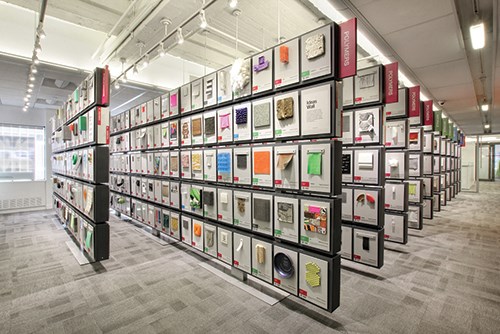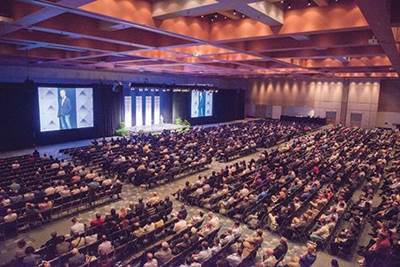IBEX 2014 report
A new home port in Florida and fair economic winds propel this boatbuilders’ convention to its best exhibitor/attendee turnout in years.
Organizers of the 24th International BoatBuilders’ Exhibition & Conference (IBEX) promised a “new city, new technology and a whole new experience.” The raw numbers — 6,900 attendees, a 47 percent increase vs. 2013, and 558 exhibiting companies, up 15 percent vs. last year — say they delivered, and they supported National Marine Manufacturers Assn. (NMMA, Washington D.C.) president Thom Dammrich’s assessment of the boat industry’s health: "We're anticipating good times ahead for recreational boating. The industry continues to see healthy growth with retail expenditures increasing 3.2 percent in 2013 to $36.9 billion,” he noted in his annual State of the Industry address. “Americans are taking to the water in record numbers, and we're anticipating continued steady growth of 5 to 7 percent in new powerboat sales through 2014.” He also reiterated the importance of recreational boating as a $36.7 billion industry in the U.S., which provides 338,526 jobs at 34,833 marine industry businesses.
IBEX 2014, cosponsored Sep. 30-Oct. 2 by NMMA and Professional BoatBuilder magazine, presented attendees not only with a new bayside venue, the Tampa Convention Center (Tampa, Fla.), but also an updated program that included interactive displays on the show floor. The Connected Boat, for example, demonstrated how sensors, electronics and cellular, satellite and global Internet systems work together to provide the connectivity and digital functionality demanded by today’s boat customers — embedded sensors are an aspect of connectivity where composites could be of aid. In the 3D Digital Workshop, attendees were instructed not only about various 3-D scanners and printers operating onsite, but also in the latest 3-D computer design software used to gain production efficiencies in, for example, cutting materials and machining plugs and tools. Located within the Composites Pavilion, Material ConneXion (New York, N.Y.) provided an on-site physical library of more than 40 innovative material samples. Material scientist Sarah Hoit explained potential safety and impact applications for an auxetic textile, that is, one woven with a negative Poisson’s ratio so that it becomes thicker when stretched, not thinner. Attendees also handled samples of Italian marble combined with layers of adhesive, fabric and resin to form a flexible stone veneer less than 0.5 mm/0.02 inch thick and 0.4 kg/m² (0.08 lb/ft²) in areal weight, perhaps perfect for that next high-end line of boats.
“We have over 7,500 advanced and innovative materials in our onsite and online libraries around the world,” says Hoit. “What we brought to IBEX is just a small sample of the materials that we think could be translated to the marine industry which are currently being used in other industries like apparel and automotive. This cross-pollination often provides a direct solution or sparks an idea for a new innovation.”
There was definitely an audible hum of activity at this year’s show. IBEX’ challenge now will be to maintain this level of energy and invention as it moves back to Louisville, Ky., Sept. 15-17, 2015.
Despite the generally elevated show atmosphere news, the number of seminars was down again this year — from 94 in 2012, to 75 in 2013, to 55 in 2014. Presentation quality, however, was not. Hodgdon Yachts (East Boothbay, Maine), for example, presented “Tooling for Prepregs” and “Prepreg Fiber Cutting and Placement,”— topics in keeping with that boatyard’s current project: The 100-ft/31m all-carbon fiber composite racing sailboat, Commanche, for Netscape cofounder and competitive sailor, Jim Clark.
Seminars & tutorials
Composites Consulting Group (CCG, DeSoto, Texas) offered “Infusing a Carbon Fiber Multihull” and “Foil Design,” presented by renowned catamaran designer Gino Morelli of Morelli & Melvin (Newport Beach, Calif.), the designers of Emirates Team New Zealand 34th America’s Cup Catamaran. Morelli discussed the challenges of designing and building the highly loaded carbon composite daggerboard and rudder foils that enable foiling sailboats to literally take flight. Finally, in conjunction with the 3D Digital Workshop, there was a session that introduced design for 3-D printing.
For builders of production powerboats and sailing yachts elsewhere in the boatbuilding spectrum, seminars ranged from the pragmatic, such as “Shop Floor Realities of Infusion,” “Low-Cost Post-Curing Options” for epoxy resin to those like “Wet-Preg Best Practices,” which reviewed the practical factors to consider when deciding between infusion and wet-preg — i.e., prepreg (fabric impregnated with resin) made in the shop, layed while still wet and then vacuum-bag cured.
In their postcuring seminar, Heny Elliot, instructor for the International Yacht Restoration School’s (IYRS, Newport, R.I.) Composites Technology program, and copresenters from Lyman Morse Boatbuilding Co. (Thomaston, Maine), listed numerous inexpensive (less than $300), high-precision controllers and data loggers that reportedly enable temperature management to within ±5°F/±2.8°C in shop-built, temporary ovens, using appropriate thermocoupling and air flow.
Composites One (Arlington Heights, Ill.) held a free four-hour “Closed Molding Super Session” on Monday, Sep. 29. It featured actual manufacturers’ case studies, detailing different ways to set up a closed-molding shop and how to troubleshoot production issues. Live on the exhibit floor Wednesday, Dr. Jason Gibson, chief applications engineer for Composites One, presented a one-hour “Advanced Composites Workshop,” showing examples of parts made from carbon fiber, epoxy resin and other materials and discussing where these make sense in marine applications.
On the show floor
Moldmakers that serve marine customers, notably, called attention to technological change in tool manufacturing. Matt Chambers, president of Marine Concepts (Cape Coral, Fla.), a company that produces a large amount of molds and tooling for the marine industry, noted that his company is building more infused tooling, reflecting increased demand for the higher-quality and vacuum integrity that closed molding production requires. “People have said for a while that closed molding would sweep the industry,” said Chambers, “but we are seeing it really grow now.” He observed that marine manufacturers are looking for ways to reduce manufacturing costs while improving product performance. And Janicki Industries (Sedro-Woolley, Wash.) told the story of Northwest Marine Concepts/Design Concepts (Ferndale, Wash.), a venerable boatbuilder for 40 years, which Janicki will help put its backlogged SeaSport Commander line back into production after a fire destroyed legacy hull tooling. With no existing unassembled hulls or digital models to work from, Janicki plans reverse engineer a finished hull and deck using laser scanners and Siemens PLM Software Inc. (Siemens PLM, Plano, Texas) to create an updated and symmetric CAD model that will be used to fabricate new plugs and molds. “We get to use modern metrology technology to restore what this great boatbuilder lost, but also improve it,” says Andy Bridge, Janicki director of commercial & industrial sales. He estimates two weeks from laser scanning to digital files suitable for new pattern fabrication. “We’ll have them back in production quickly with new improved precision tooling and a secure digital archived model,” Bridge notes, adding, “This reverse-engineering approach can be performed on many older marine molds that were hand lofted as a prudent risk reduction strategy.”
Many other exhibitors in the IBEX Composite Pavilion at IBEX 2014 had much that was new for those who fabricate composite boat structures. Set an online course to a more thorough exposition of products premiered at this and other recent trade events, available throughout the month of December here.
Related Content
MFFD thermoplastic floor beams — OOA consolidation for next-gen TPC aerostructures
GKN Fokker and Mikrosam develop AFP for the Multifunctional Fuselage Demonstrator’s floor beams and OOA consolidation of 6-meter spars for TPC rudders, elevators and tails.
Read MorePlant tour: Albany Engineered Composites, Rochester, N.H., U.S.
Efficient, high-quality, well-controlled composites manufacturing at volume is the mantra for this 3D weaving specialist.
Read MorePEEK vs. PEKK vs. PAEK and continuous compression molding
Suppliers of thermoplastics and carbon fiber chime in regarding PEEK vs. PEKK, and now PAEK, as well as in-situ consolidation — the supply chain for thermoplastic tape composites continues to evolve.
Read MoreCompPair adds swift prepreg line to HealTech Standard product family
The HealTech Standard product family from CompPair has been expanded with the addition of CS02, a swift prepreg line.
Read MoreRead Next
CAMX 2014 show report
Bigger, better and more inclusive than any previous U.S. composites trade event, the inaugural show turns North American eyes forward to the future.
Read MoreDeveloping bonded composite repair for ships, offshore units
Bureau Veritas and industry partners issue guidelines and pave the way for certification via StrengthBond Offshore project.
Read MorePlant tour: Daher Shap’in TechCenter and composites production plant, Saint-Aignan-de-Grandlieu, France
Co-located R&D and production advance OOA thermosets, thermoplastics, welding, recycling and digital technologies for faster processing and certification of lighter, more sustainable composites.
Read More


























